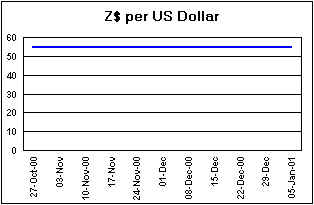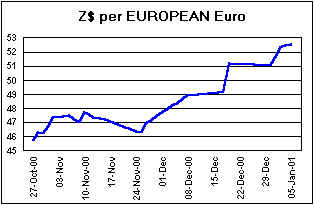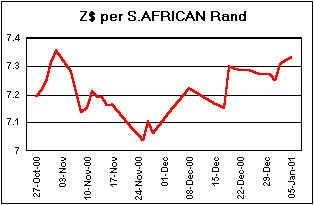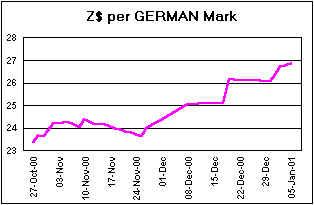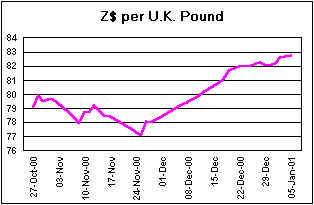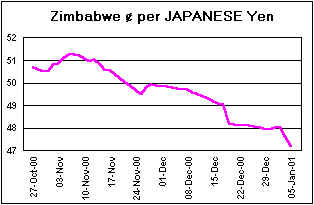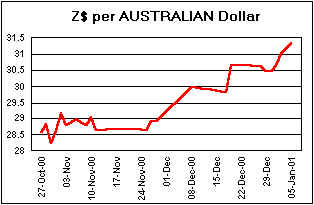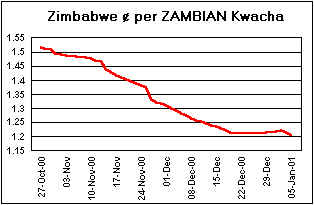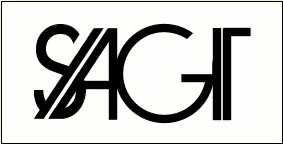|
The Market
Friday 5th January 2001
THE MARKET
In the just ended year, the ZSE had a disappointing performance, as political
developments took centre stage. The industrial index closed the year up a
dismal 22%, way below the gain of 125% in the previous year, while the mining
index was up by 15% as commodity prices remained weak. In US dollar terms the
industrial index was down 16% while the mining index was down by 20%.
Violence characterised the June elections in which the opposition MDC
surprised the ruling ZANU PF party by clinching 57 seats. The violence and
Government reaction attracted a lot of adverse attention from the
international community, resulting in foreign investors exiting the country
for more stable emerging markets. After the elections, violence on war
veteran occupied farms escalated disrupting economic activities and further
depressing the economy.
Despite numerous calls from business and regional political leaders, the
violence has persisted and lives have been lost further depressing investor
sentiment. The government has since embarked on a fast track land
resettlement exercise but has not been able to offer the resettled farmers
required inputs or infrastructure to assist in getting the new farmers
started. This has raised numerous concerns about the food and foreign
currency supplies in the year. Already tobacco output is forecast to be 30%
down whilst prices are expected to remain flat. There is unlikely to be an
immediate maize shortage because the GMB was unable to buy
off all maize from farmers due to financial constraints.
On the other hand, seed shortages in the year 2002 are likely to develop as
nearly half of the country certified seed growers have been affected by the
land resettlement exercise. This is disheartening because there is strong
evidence that Zimbabwe is becoming a leading regional seed grower, through Seedco,
whose regional seed sales are expected to be $1 billion in the year to
February 2001. Seedco, currently trading at 630 was up by
68% in the year 2000. Investors have been anticipating a good dividend from
the company. Other agro-industrial companies have not been spared as their
farms have either been listed or occupied by war veterans disrupting their
farming and downstream operations.
This has dealt a major blow to profitability as companies have lost their
export markets after failing to supply commodities on time. The only
agro-industrial counter to perform well in the year 2000 was Cottco,
which has benefited from firm cotton prices. The company, whose year ends in
March, is expected to do well and the share price jumped 848% to 1650 at the
end of December 2000.
Manufacturing companies came under tremendous pressure during the year 2000,
as interest rates soared while demand for products was generally weak as
consumer incomes declined. Macmed, Randalls
and Merspin asked for the suspension of their trading on the
ZSE as they failed to pay off creditors. A number of
companies also released cautionary statements warning shareholders of
expected low profits and corporate restructuring. The strain on manufacturing
companies was all too evident in the financial results reported by the
companies in the year 2000. Because of the intense linkages between
commercial agricultural activities and manufacturing, the disruption in the
agricultural sector contributed immensely to the decline in manufacturing
sector. This contributed significantly to the volatility of the market as the
chart below shows.
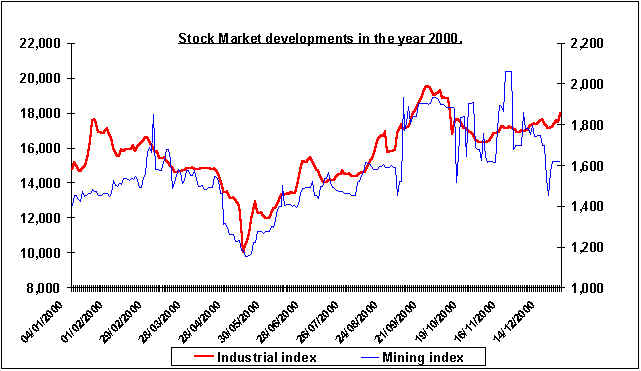
The tourism sector was also adversely affected by the harsh economic and
political climate during the year. Zimsun is expected to
report a loss for the year to March 2001. The share price was down 52% during
the year 2000. RTG was listed on the ZSE at
150 but closed the year at 55, 63% below the issue price, as trading
conditions worsened. In the year 2001, tourism companies are likely to remain
distressed as tourists shun the country until the 2002 presidential elections
are out of the way. The persistent violence in by-elections and on farms has
worsened the country's image. Increasingly investors and tourists alike view
the tension in the country as potentially explosive and dangerous.
Mining counters were also depressed during the period as commodity prices
remained low and the Zimbabwe dollar/ US dollar exchange rate was fixed.
Operating costs continued to rise driven by inflation and some gold mines
were shut down as the gold price resisted the US$280 per ounce barrier. This
was despite strong growth in Europe and America. Zimbabwe lost one of its
potentially lucrative foreign currency earner, the BHP
platinum mine, as the Australian investors withdrew form the mining project,
sighting logistical problems. Platinum prices on the other
hand continued to rise from US$545 to US$602 per ounce by the end of the year
2000. Copper prices did not recover either and this
culminated in the closure of Mhangura Copper Mines. In his
2001 budget statement the Minister of Finance offered some tax incentives,
including ring fencing for the sector in order to assist in the recovery of
the ailing sector. A number of companies in the sector have been making
losses as a result of the difficult trading conditions and will not benefit
from the tax incentives at this moment.
Financial counters also had a fair share of problems in the year 2000.
Specific provisions were substantially up as companies failed to repay loans.
The compulsory acquisition of commercial farms also left a number of banks
exposed as the governments insists that it will not pay for the land and the
farmers loan obligations. In 1999, financial counters were the main driver
behind the 125% rise in the industrial index. Barclays
closed the year unchanged at 1600. NMB closed the year up
400% to 17500 followed by Old Mutual up 77% to 18700. Kingdom
was also up 70% to 920. The counter has since reached an all time high of
1200. Investors are excited about the company's retail banking project.
On the macro-economic front, Zimbabwe's crisis worsened in the year 2000 as
inflation remained high because of the government lax fiscal policy.
Inflation averaged 58% in 1999 is now expected to average 57% in 2000,
assuming a slight increase in the December figure. This environment affected
the operations of many companies as interest rates soared whilst consumers'
purchasing power fell. Operating margins for companies were consequently down
in 1999 and companies began to downsize and rationalise their operations. The
main cause of inflation has been the financing of the budget deficit through
domestic borrowing. Below is the chart showing the 90-day effective TB yield.
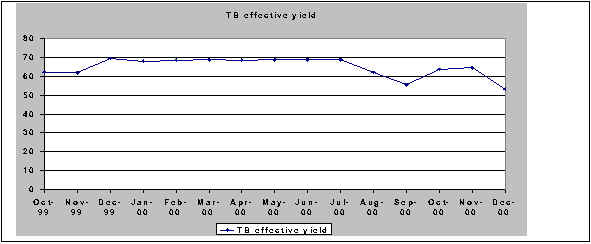
As a result of persistent inflation short-term interest rates have remained
high discouraging any meaningful investment in manufacturing projects.
Because of the high cost of capital, companies found it difficult to expand
existing production capacity as demand was also weak.
Hardest hit by the high interest rates were companies that were heavily
geared and were unable to service their debt. A number of companies either
closed down of rationalised their operations to survive. A chronic shortage
of foreign currency also developed as the government officially controlled
the US dollar/Zimbabwe dollar exchange rate. This negatively affected
exporters as their competitiveness on the international markets was eroded.
The shortage of foreign currency persisted in 2000 resulting in a critical
shortage of fuel and disruptive power cuts. Manufacturing and mining
companies were hardest hit during this period. Overall manufacturing output
was down by 5,2% in 1999 and is expected to decline by 10,5% in the year
2000.
We expect the manufacturing sector, especially import and agriculture
dependent sub sectors to deteriorate further in 2001 as a result of
persistent forex shortages and weak domestic demand. The decline in the
manufacturing activity has been worsened by the land crisis, which has seen
the demand for agro-industrial products falling. Luxury goods have not been
spared, as consumers rearrange their baskets in favour of basic commodities.
The government is facing increasing pressure from consumers to reduce the price
of basic commodities. In 1999 following some food riots in January the
government resorted to controlling the prices of basics in order to cushion
consumers. The impact of this on profits was particularly felt by companies
in the milling and baking industry, resulting in the closure of some
companies.
It Is also anticipated that consumers will continue to experience erosion of
their purchasing power as inflationary pressures arising from food shortages
intensify in 2001. Although inflationary pressure was stronger in 2000 when
compared to 1999, annual inflation slowed down whilst month-on-month
inflation remained high. The raising of the tax threshhold from $30 000
(US$545) to $60 000 ($1090) per annum in January 2001 did raise some hopes
that consumption of luxury products could be stimulated but given the
prevailing harsh economic climate consumers are likely to continue going for
basics. This is particularly true for low and medium income earners who are
increasingly finding it difficult to cater for their basic needs.
Consequently capacity utilisation has been cut as unit costs escalate while
the demand for most commodities, especially those considered to be luxuries
by consumers has fallen. It is also important to note that the harsh economic
climate has not only led companies to restructure and downsize, It has also
resulted in consumers rearranging their consumption baskets in favour of
basic commodities. The chart below compares foodstuff and clothing and
footwear output growth.
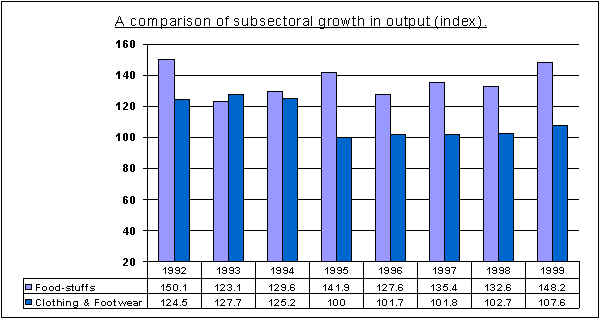
As the chart illustrates food output in the manufacturing sector has grown in
1999 after registering a slight decline in 1998 whilst clothing and footwear
out has been more else stagnant. The outlook for the Zimbabwean economy,
particularly the key economic growth driving sectors Agriculture and
manufacturing, is rather gloomy as already pointed out. Unless the government
changes its policies the economy is expected to continue deteriorating with
disastrous consequences on both workers and employers alike. Key to the
recovery of the economy are the following factors.
·
The swift resolution of the land issue and
restoration of the rule of law
·
Withdrawal of troops from the DRC, which should help
in reducing foreign shortages
·
Restoration of relations with the International donor
community to alleviate foreign currency shortages and reduce interest burden
on debt
·
Reduction in government recurrent expenditure and
focussed development of infrastructure to encourage investment
·
Consistent policy implementation.
|
